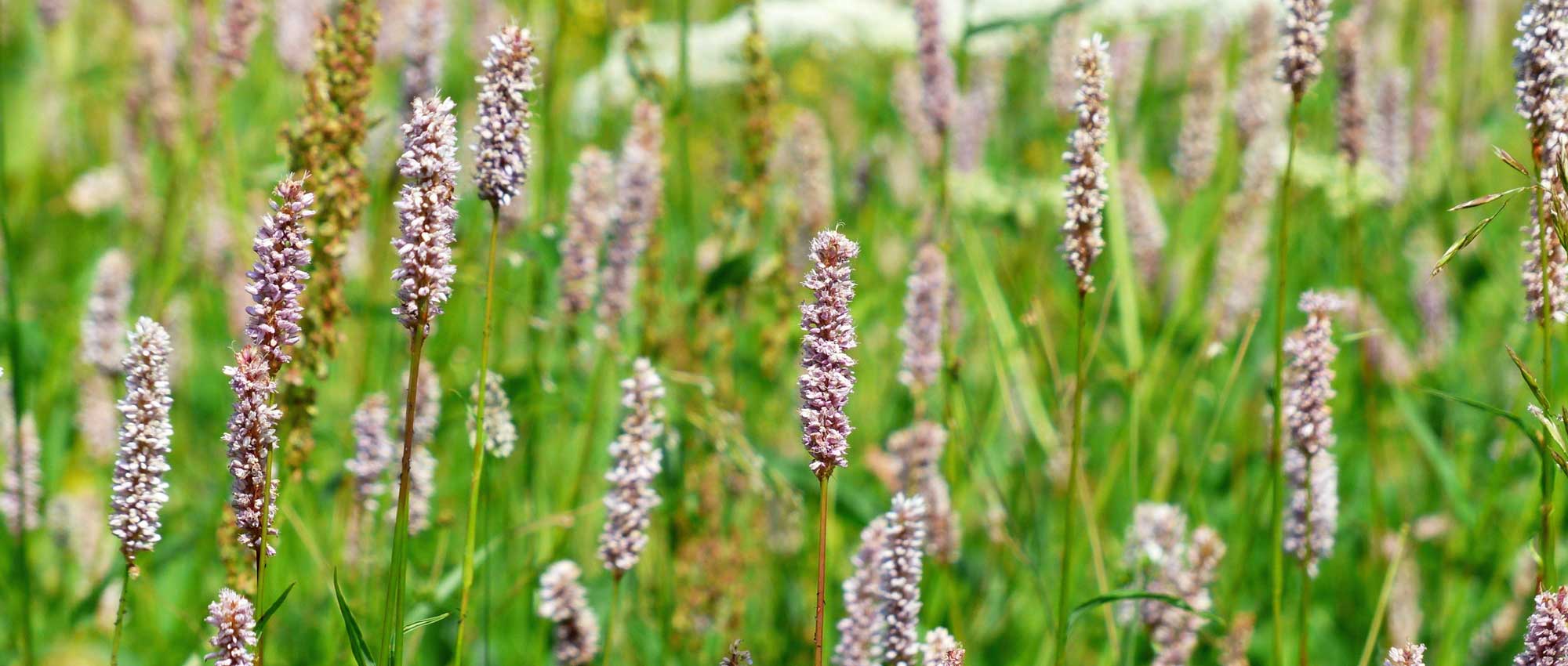
Persicarias or knotweeds: 10 ideas for successful combinations
Discover our inspirations!
Contents
The persicarias also known as Polygonum or knotweeds, are perennials whose light and delicate flowering immediately creates a very natural appearance. They have an undeniable rustic charm, reminiscent of wild meadows. Landscape designer Piet Oudolf uses them to compose naturalistic gardens that blend countless grasses and perennials (agastaches, echinaceas, eupatoriums, sanguisorbas…), achieving a beautiful effect of a flowering meadow. However, persicarias with unique foliage, such as ‘Red Dragon’ (purple) or ‘Purple Fantasy’, are incorporated into gardens with a much more “crafted” appearance, less wild. With their surprising foliage, they can fit into more graphic and formal flowerbeds. Affinis persicarias can be used as ground cover or in rockeries. Being very resilient and vigorous, persicarias easily find their place in a low-maintenance garden. They have the advantage of providing long-lasting flowering in shaded gardens and heavy soil, where other plants struggle to grow and where solutions are lacking to flower these spaces! Discover all our tips for pairing persicarias: which plants to combine them with, for what style of garden, and for what visual effect?
To create a shade garden
Persicaria integrates very well into a woodland edge garden, a location that is both cool and shaded. Preferably choose varieties with white flowers: they will brighten up the shaded bed and create a lovely contrast. You can pair them with the pure white flowers of Japanese anemones (such as those from the ‘Honorine Jobert’ variety). Add some plants with decorative foliage: ferns, hostas, or rodgersia. And in front of them, a tapetum of numerous low flowers, for example, wood hyacinths or cyclamen.
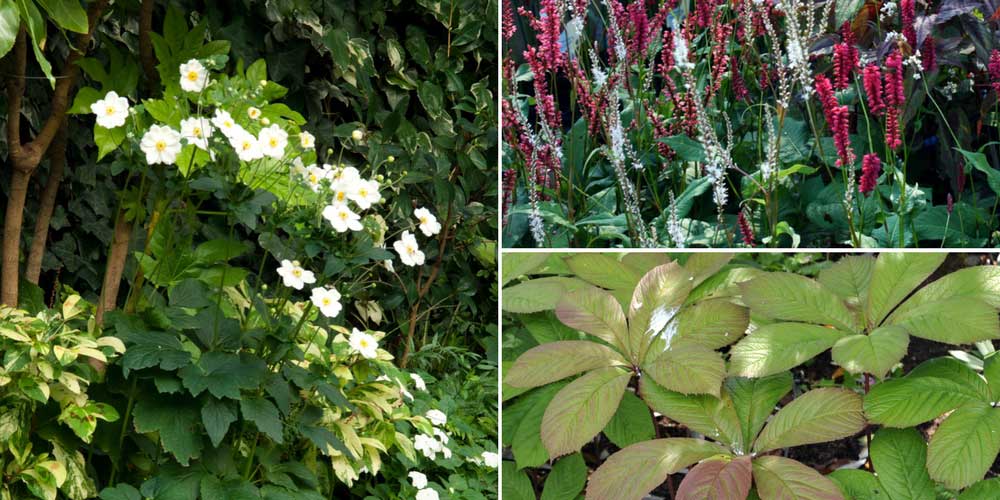
Anemone ‘Dreaming Swan’, Fatsia and Persicaria ‘Painter’s Palette’ (Photo: Alexandre Petzold / Biosphoto) – Persicaria amplexicaulis ‘Alba’ and ‘Taurus’ – Rodgersia pinnata
To create an exotic garden
Some persicarias can be included in the composition of an exotic-style garden, which is very disorienting. Thus, you can place Persicaria polymorpha, an impressive and very lush knotweed, alongside the hardy palm Trachycarpus fortunei, Gunnera manicata, and Datisca cannabina, two perennials that, like the persicaria, enjoy rich and cool soils. These plants will surprise you with the exuberance of their foliage and will add a lot of volume to your garden. You can also create an exotic bed with Persicaria runcinata ‘Purple Fantasy’. Pair it with other plants that have original foliage and warm tones, such as Castor beans, Cannas, Fatsia japonica, or Kniphofias. Position a few clumps of the grass Hakonechloa macra at their feet. This will result in a bed with vibrant colours and impressive foliage.
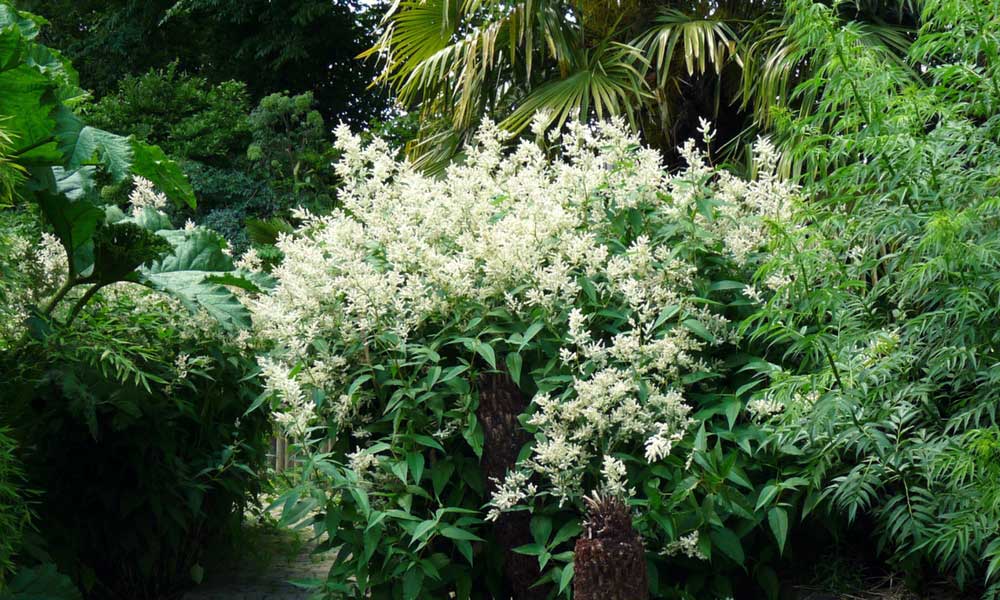
Persicaria polymorpha, Gunnera manicata, Trachycarpus fortunei, and Datisca cannabina in an exotic setting (Photo: Le Clos du Coudray)
Discover other Persicaria
View all →Available in 3 sizes
Available in 1 sizes
Available in 1 sizes
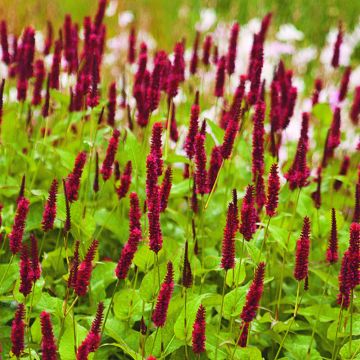
Available in 2 sizes
Available in 0 sizes
Available in 2 sizes
Available in 2 sizes
Available in 1 sizes
Available in 1 sizes
Available in 1 sizes
To play with colours using decorative foliage
Some persicarias offer stunning variegated foliage… take advantage of it! For example, use the green and white foliage of Persicaria virginiana ‘Variegata’ to bring brightness to a shaded border. As for Persicaria runcinata ‘Purple Fantasy’, its triangular leaves immediately create a very graphic atmosphere! Its warm and contrasting tones allow it to be integrated into an exotic border. You can also create a beautiful purple scene that combines the dark shade of Persicaria microcephala ‘Red Dragon’ with the flowering of Geranium phaeum. Plant them in the shade, under trees, in fairly large groups. You can accompany them with some hostas or ferns.
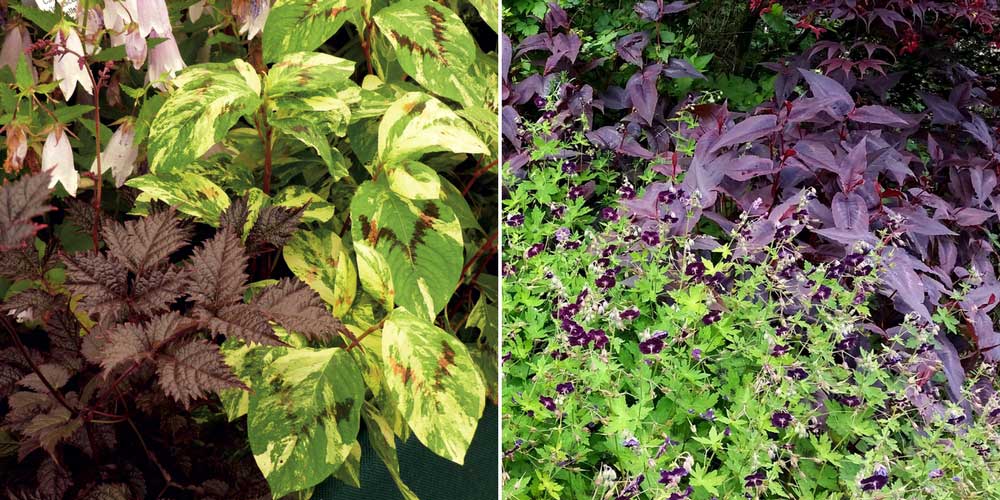
Persicaria virginiana ‘Painter’s Palette’ and Astilbe ‘Chocolate Shogun’ – Persicaria ‘Red Dragon’ and Geranium phaeum
To create a rockery, with tapetum varieties
Persicarias also allow for the creation of fresh rockeries, provided you choose a slightly shaded location. Persicaria affinis ‘Darjeeling Red’, Persicaria vaccinifolia, and Persicaria tenuicaulis are ground-cover plants that integrate very well into a rockery! Plant them in small groups of at least three plants of each species. Install some saxifrages, geraniums, stemless gentians, and ferns alongside them.

Asplenium scolopendrium – Saxifraga cotyledon ‘Southside Seedling’ – Persicaria affinis ‘Darjeeling Red’
For a contemporary, highly graphic garden
Create a contemporary garden with a minimalist design and geometric lines. Install some clumps of ornamental grasses (Stipa or Miscanthus) accompanied by graphic and light plants, such as Gaura, Verbena from Buenos Aires, or Persicaria bistorta. Place some conifers or trimmed boxwoods to structure the bed. Next to them, Persicaria runcinata ‘Purple Fantasy’: its triangular foliage in warm, contrasting tones will have a stunning effect. Position some large pots planted with bamboos or horsetails to add height. Add lighting and furniture with very clean and geometric shapes.
You can draw inspiration from this atmosphere!
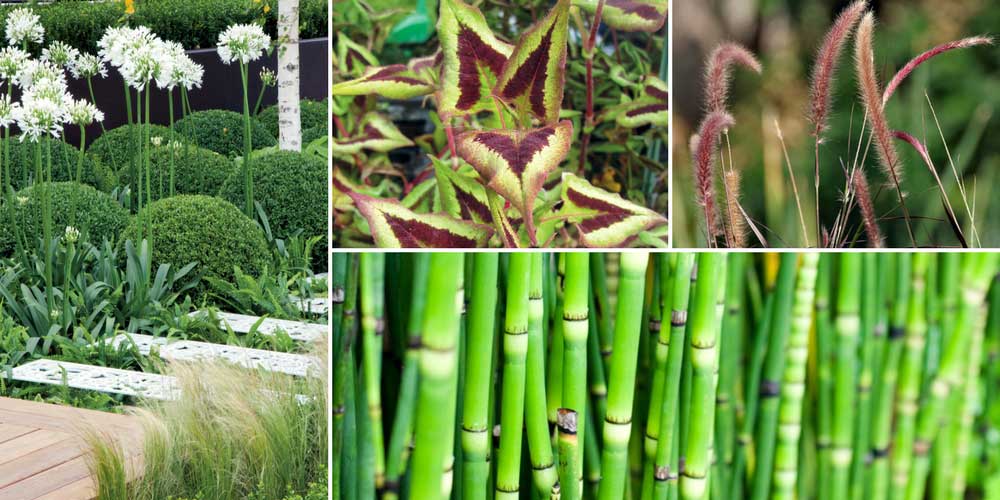
Contemporary garden with Buxus sempervirens, Agapanthus umbellatus ‘Albus’ and Stipa tenuissima (Photo Credit GAP – Elke Borkowski) – Persicaria runcinata ‘Purple Fantasy’ – Pennisetum setaceum – Equisetum camtschatcense (photo Masaaki Komori)
For a naturalistic garden
Compose a garden inspired by nature, featuring grasses (Miscanthus or Pennisetum) and airy flowering plants with a very free and tall habit. They will bring a light and wild touch to your garden. You can thus combine Persicaria bistorta with marsh spurge (Euphorbia palustris) and Camassia, a lovely bulb with delicate starry blue flowers.
You can also pair Persicaria amplexicaulis with river thistle (Cirsium rivulare) and marsh sage (Salvia uliginosa), two beautiful perennials that thrive in cool, rich soils and share the same growing conditions as the knotweed. If you have space, plant a large number of specimens and mix the species to create a beautiful wild meadow effect! The garden you will achieve will require very little maintenance.
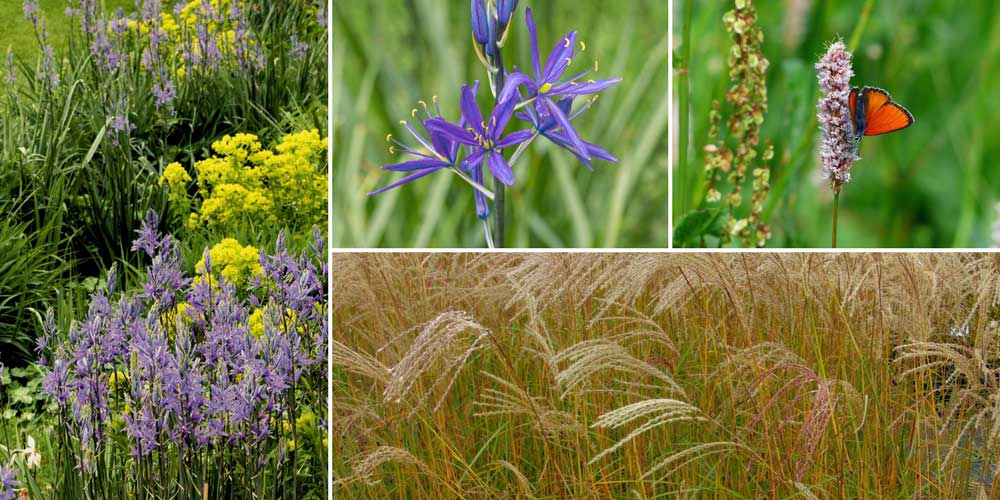
Camassia and Euphorbia palustris ‘Teichlaterne’ – Camassia leichtlinii ‘Caerulea’ – Persicaria bistorta – Miscanthus sinensis ‘Flamingo’
For a typically English cottage garden
To stay in natural styles, the knotweed integrates very well into cottage gardens. These are English gardens with a lush and wild appearance, offering an abundance of flowers in soft and romantic shades (white, blue, pink, mauve…). These gardens are perfect for highlighting old stone houses. Thus, you can place a climbing rose or a clematis in the background, against a wall. Then position Persicaria bistorta ‘Superba’, paired with campanulates, centauries, or alliums, in groups of three to five young plants of each species. And place a few Lobelia erinus or Aster dumosus right in front. Finally, you can add a few vintage-style decorative objects.
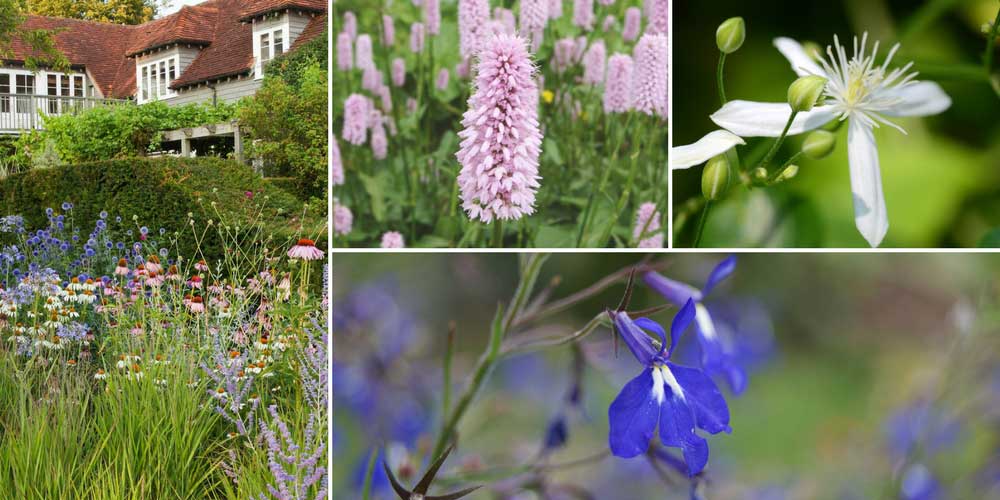
Persicaria bistorta – Clematis terniflora (photo Amada44) – Lobelia erinus ‘Richardii’ (photo Danny Steven S.)
On the edge of the path!
Compose a colourful and vibrant path border by combining autumn-flowering plants in warm and bright tones! Enjoy the stunning flowering of Dahlias, Heleniums, and Phlox ‘Alpha’! The delicate spikes of the grass Pennisetum incomptum complement those of Persicaria amplexicaulis, bringing poetry and lightness. They help soften the bright blooms of dahlias and heleniums.
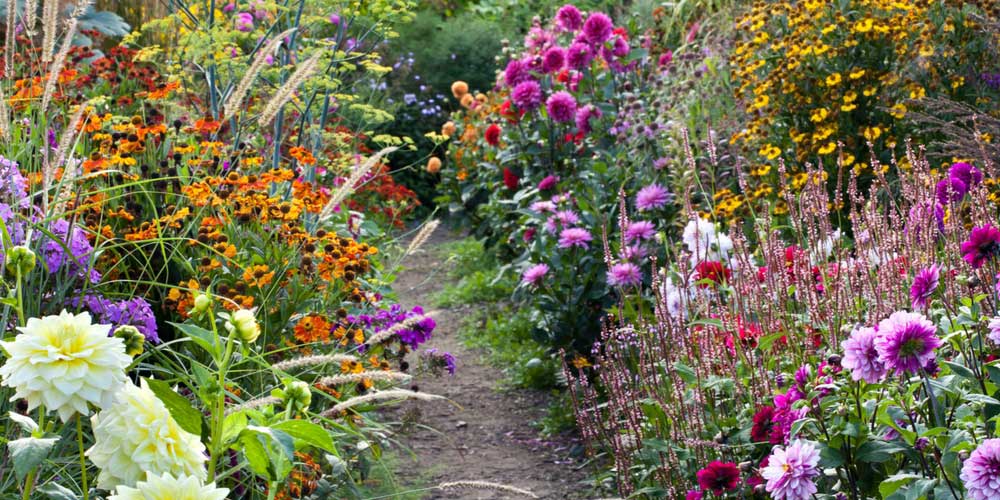
Persicaria amplexicaulis, Dahlias, Pennisetum incomptum, Helenium, and Phlox ‘Alpha’ (Copyright GAP photos – Robert Mabic)
To green the banks of a pond
As persicaria enjoys cool or moist soils, you can plant it at the edge of a pond. Plant it alongside flowering rush (Butomus umbellatus), irises (including the essential Iris pseudacorus), marsh forget-me-not (Myosotis scorpioides), and willowherbs. Add some height by incorporating horsetails (with a rhizome barrier).

Persicaria polymorpha and roses
To create an autumn border
Most persicarias bloom until autumn, allowing you to enjoy a flower-filled garden until the first frosts. You can create a bed with shades of red, pink, mauve, and orange by placing a few clumps of Persicaria amplexicaulis ‘Pink Elephant’, accompanied by Sedum ‘Herbstfreude’, Dahlias, Japanese Anemones, and a few grasses placed here and there (Calamagrostis or Miscanthus), with a tapetum of hardy geraniums at their feet.
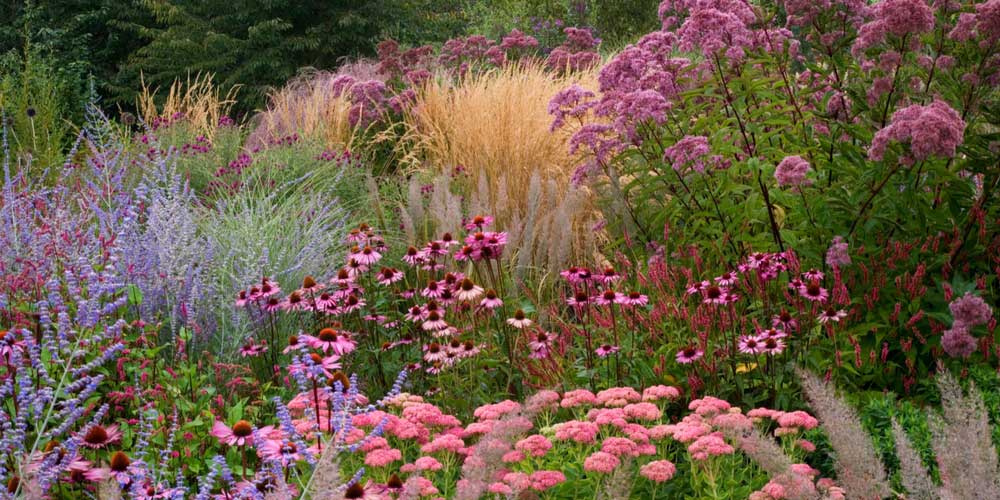
Sedum ‘Herbstfreude’, Echinacea purpurea ‘Rubinstern’, Eupatorium purpureum, Perovskia ‘Blue Spire’ (Photo: GAP photo / Clive Nichols / Designer Judy Pearce )
- Subscribe!
- Contents































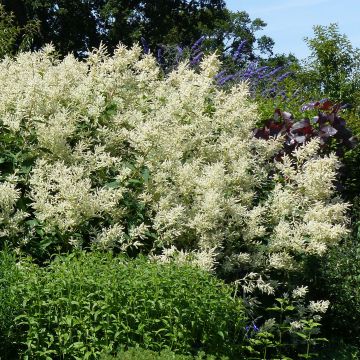
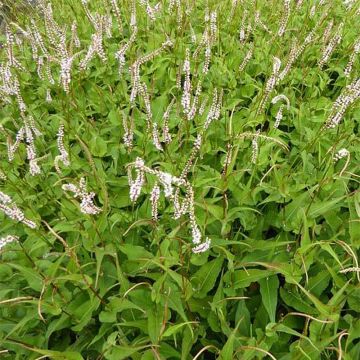
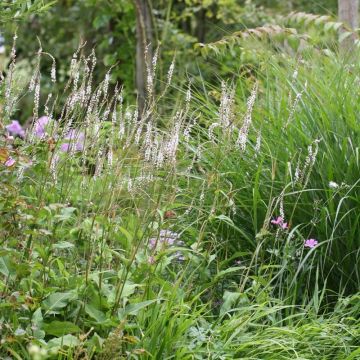
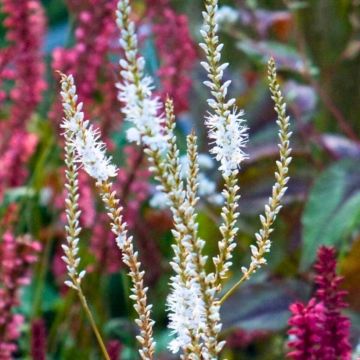
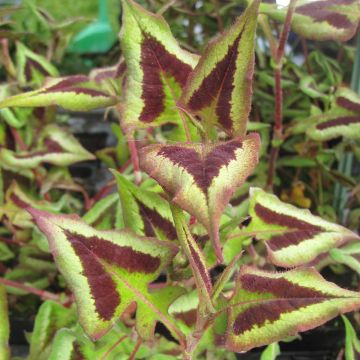
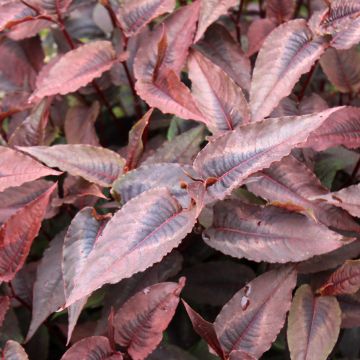

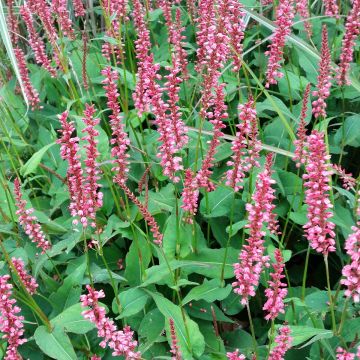
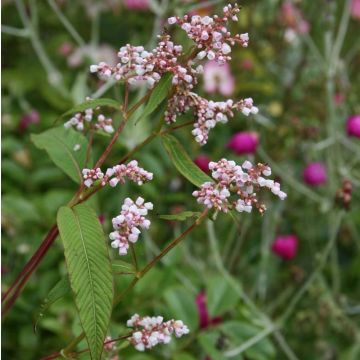
Comments